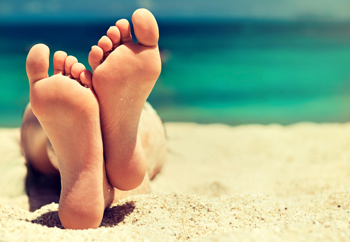 Heel pain may be increased in overweight patients. This can be a result of the added weight that the heels must endure, and chronic foot conditions may develop. The additional weight may cause obese patients to lose interest in exercising, yet exercise is an essential key to losing unwanted pounds. Some patients notice that their foot size has increased, or that their feet have become wider. Additionally, specific forms of arthritis may develop, which can include gout or osteoarthritis. Swelling, pain, and overall foot discomfort may be felt from the strain of the extra weight, in addition to plantar fasciitis and arthritis in the back of the foot. If you are overweight and are experiencing any type of foot pain, it is strongly recommended that you speak to a podiatrist who can properly diagnose and effectively treat this type of pain.
Heel pain may be increased in overweight patients. This can be a result of the added weight that the heels must endure, and chronic foot conditions may develop. The additional weight may cause obese patients to lose interest in exercising, yet exercise is an essential key to losing unwanted pounds. Some patients notice that their foot size has increased, or that their feet have become wider. Additionally, specific forms of arthritis may develop, which can include gout or osteoarthritis. Swelling, pain, and overall foot discomfort may be felt from the strain of the extra weight, in addition to plantar fasciitis and arthritis in the back of the foot. If you are overweight and are experiencing any type of foot pain, it is strongly recommended that you speak to a podiatrist who can properly diagnose and effectively treat this type of pain.
Obesity has become very problematic at this point in time and can have extremely negative effects on the feet. If you’re an obese individual and are concerned about your feet, contact one of our podiatrists from Canonsburg Podiatry Associates. Our doctors can provide the care you need to keep you pain-free and on your feet.
Obesity and Your Feet
Since your feet are what support your entire weight when standing, any additional weight can result in pain and swelling. Being overweight is one of the main contributors to foot complications.
Problems & Complications
Extra Weight – Even putting on just a few extra pounds could create serious complications for your feet. As your weight increases, your balance and body will shift, creating new stresses on your feet. This uneven weight distribution can cause pain, even while doing the simplest tasks, such as walking.
Diabetes – People who are overweight are at serious risk of developing type-2 diabetes, which has a drastic impact on the health of your feet. As you get older, your diabetes might worsen, which could lead to loss of feeling in your feet, sores, and bruises. You could also become more prone to various infections.
Plantar fasciitis – Pressure and stress that is placed on muscles, joints, and tendons can trigger plantar fasciitis, which is an inflammation of tissue that forms along the bottom of the foot.
If you have any questions please feel free to contact our office located in Canonsburg and McMurray, PA . We offer the newest diagnostic and treatment technologies for all your foot and ankle needs.




